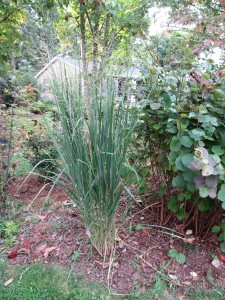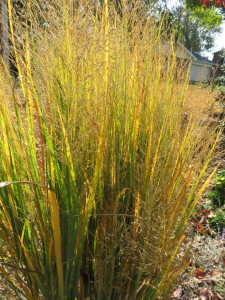Northwind switchgrass (Panicum virgatum ‘Northwind’) is a 4 to 5 feet tall native prairie grass (USDA hardiness zones 4–9). There are many fine switchgrass varieties, but its Northwind’s vertical form and steel blue foliage that makes it a standout. Northwind switchgrass has been selected the 2014 Perennial Plant of the Year.
By mid-summer its lacy soft pinkish white inflorescences arise 1-2 feet above the foliage. In early autumn floral heads take on more of a grayish tint. The narrow grass blades also turn several shades of yellow. Its rigid form stands tall like a sentinel in the winter landscape and offer shelter to birds and other wildlife.
Switchgrass grows the best in full sunlight. Its tight upright form lets down in partial shade. Switchgrass prefers moist fertile soil, but adapts to most soil types and moisture levels. Nutritional needs are minimal, and switchgrass forages well in nutrient poor soils.
This tough prairie inhabitant sloughs off winter’s cold and summer’s heat and drought. Disease or pest problems are minimal, but may contract outbreaks of rust over a wet summer. Overcrowded crowns are best divided every 4-5 years, no easy task.
Northwind’s neat vertical stance and steel blue blade color make it ornamental pleasing in residential, roadside, and commercial properties. Northwind may stand alone or mixed with other plants in containers. It can be massed along a stream bank, or set on steep slopes or reclamation lands. Plant switchgrass for dune stabilization along coastal beaches; it tolerates high winds and salt sprays.



 Posted in
Posted in 
